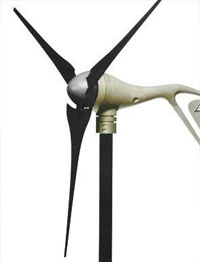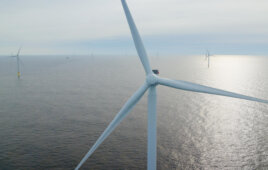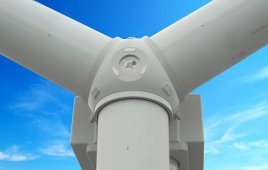In the wind turbine business there are basically two types of turbines to choose from, vertical axis wind turbines and horizontal axis wind turbines. They both have their advantages and disadvantages and the purpose of this article is to help you choose the right system for your application.

Horizontal axis wind turbine
Horizontal axis wind turbine dominate the majority of the wind industry. Horizontal axis means the rotating axis of the wind turbine is horizontal, or parallel with the ground. In big wind application, horizontal axis wind turbines are almost all you will ever see. However, in small wind and residential wind applications, vertical axis turbines have their place. The advantage of horizontal wind is that it is able to produce more electricity from a given amount of wind. So if you are trying to produce as much wind as possible at all times, horizontal axis is likely the choice for you. The disadvantage of horizontal axis however is that it is generally heavier and it does not produce well in turbulent winds.

Vertical axis wind turbine
In comes the vertical axis wind turbine. With vertical axis wind turbines the rotational axis of the turbine stands vertical or perpendicular to the ground. As mentioned above, vertical axis turbines are primarily used in small wind projects and residential applications.Vertical-Axis-Wind-Turbine This niche comes from the OEM’s claims of a vertical axis turbines ability to produce well in tumultuous wind conditions. Vertical axis turbines are powered by wind coming from all 360 degrees, and even some turbines are powered when the wind blows from top to bottom. Because of this versatility, vertical axis wind turbines are thought to be ideal for installations where wind conditions are not consistent, or due to public ordinances the turbine cannot be placed high enough to benefit from steady wind.
Filed Under: Construction, Projects





The article has been written with horizontal skin in the game. They leave out many facts.
1) horizontal turbines require massive machinery loads high off the ground
2) Vertical turbines are *much* less expensive because of #1. Just back your truck up and do your work. the heavy stuff is right on the ground, not rocking on the spine of the turbine.
3) Horizontal turbines that generate electricity are not base load. A vertical problem, but easily solved vertically. Without chemical batteries. Compressed air will drive a small horizontal turbine, (like a jet engine. It is being done right now).
4) Horizontal wind turbines rotate so fast, birds and bats can not see them. Vertical turbine motion is in a very small field that avian creatures can see them and avoid.
5) Can’t build vertical high? Poppycock! I .can build them even bigger because I can guy them! Even stack them if the local load requires. You can not guy a horizontal turbine!
I am convinced the oil industry pushes so hard on horizontal turbines because vertical will cut deep into their greasy pockets. The spend a fortune keeping them out of the market because if we begin using them, they will lose 100 times their fortunes.
I don’t understand why vertical turbines are not more common. Because it generates some more power.The only reason the would not be more common is because it needs more material’s. Or it needs gas, coal or anything like that.
I don’t understand why vertical turbines are not more common. They appear to be way more efficient than horizontal turbines. There are now horizontal turbines with no moving parts where the blades just resonate in order to produce energy.
We have a Conifer ‘Totem Pole’ in the garden of our residential area house. Basically a tree we had topped and all braches gut off now with vine type flowers covering it. It is approx 25 ft+ tall and I am thinking of puing a small wind generator on top of it, but can’t decide which axis. VA seems favourite as the roofs appear to be causing more turbulent than stable air flow. Open to suggestions?
I remember seeing vertical axis turbines where the generator is on the ground and curved sails run vertically like an egg beater. They turned continuously with winds under five mph, from any direction, since the vertical sails were wrapped in a gradual spiral, with six sails per turbine. I saw them outside Livermore Labs back in 1995. What, did propeller manufacturers push to get their propellers used instead of better designs?
Good information which enables to choose proper type of air turbine to produce electric power more efficiently. It helps me to design moni air turbines.
Windmills do work, wind turbines produce electricity. If you’re planning on putting a windmill on a roof, it might not do you much good. As for the design, it sounds completely doable
I am thinking of making a rotor for Vertical axis wind mill which will appear just like the rotor of an exhaust fan. It will be made odAcrylic sheets and vanes may be of FRP or Acrylic. If it works I hope it may be suitable to mount on almost every building roof top. Has any one tried it? Is it practcable?
A.M.Oke.FIE